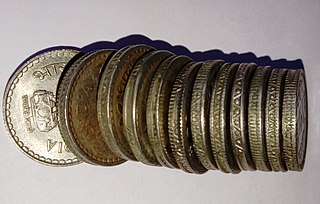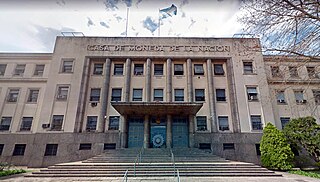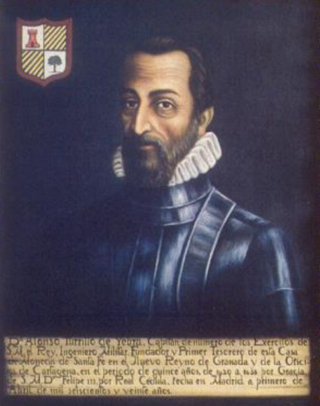

The Coining House is a former royal mint in Segovia, Spain, which dates back to the 1500s. Today, it is a museum dedicated to coins, industrial heritage and Segovia's famous aqueduct. [1]


The Coining House is a former royal mint in Segovia, Spain, which dates back to the 1500s. Today, it is a museum dedicated to coins, industrial heritage and Segovia's famous aqueduct. [1]
The royal mint was a coining factory that Philip II ordered to be built in the end of 1580. He was aware of the new rolling and coining system in which the involvement of the use of machinery and devices were moved by hydraulic wheels. The hydraulic wheels technique had been already operating in several cities in Europe. Archduke Ferdinand of Tyrol managed to get all the equipment necessary in order for the king to proceed. The coining house was the first mechanized factory in Spain. [2]
In 1582, a team of experts travelled to Spain from the Austrian territory of Tyrol in search for the most fitting location in which they could construct the building that would stock the machinery. The property chosen was owned by Antonio de San Millán and was located on the banks of the Eresma River. Previously, the property was used to grind cereal and to fabricate paper. The construction of the new building began on November 7, 1583 in which they used plans drawn from Juan de Herrera, who at that time was considered the most famous Spanish architect. Together, Herrera, the king, and the German technicians met at the old mill to mutually decide the upcoming procedures. [3]
The technology was updated in the 18th century with the introduction of the flywheel press.

During the Napoleonic Wars the mint fell under the control of Joseph Bonaparte. With the restoration of Fernando VII coins were minted for him and his successors until the deposition of Isabel II: the last coining was in 1869.
It was built in the 16th century, commissioned by Philip II to one of the most important architects, Juan Herrera. The first draft of the construction was made by Juan Herrera and a group of tyroleans that were sent by the archduke and since then the place has stayed almost intact. It is an industrial building located between the Eresma river and The garden of Poets. The building was in a state of deterioration after its manufacturing inactivity from 1968 on. There has been a long rehabilitation process that started in 1998 with the governments protocol of collaboration to commence rehabilitation but the project was actually executed between 2007 and 2011. [4]
The building was sold and from 1878, it was transformed into a flour factory. The flour production continued until November 1967, and from then on the building was abandoned, sold, and then acquired in 1989 by the municipality. On February 14, 2007, the rehabilitation began. Today, the Royal Mill Mint is the jewel of the Spanish Mints and is considered to be the oldest industrial architecture sign still standing around the world. [5]

Segovia is a city in the autonomous community of Castile and León, Spain. It is the capital and most populated municipality of the Province of Segovia. Segovia is in the Inner Plateau, near the northern slopes of the Sistema Central range and on a bend of the Eresma river.

In numismatics, the term milled coinage is used to describe coins which are produced by some form of machine, rather than by manually hammering coin blanks between two dies or casting coins from dies.

A mint is an industrial facility which manufactures coins that can be used as currency.

The Casa de Moneda de México is the national mint of Mexico and is the oldest mint in the Americas.
The commemorative coins of Spain are minted by the Real Casa de la Moneda

The Aqueduct of Segovia is a Roman aqueduct in Segovia, Spain. It was built around the first century AD to channel water from springs in the mountains 17 kilometres (11 mi) away to the city's fountains, public baths and private houses, and was in use until 1973. Its elevated section, with its complete arcade of 167 arches, is one of the best-preserved Roman aqueduct bridges and the foremost symbol of Segovia, as evidenced by its presence on the city's coat of arms. The Old Town of Segovia and the aqueduct, were declared a UNESCO World Heritage Site in 1985.

The Casa de Moneda de la República Argentina is the Argentine mint, controlled by the Argentine government and administratively subordinated to the Ministry of Economy. It was established in 1875 as "Casa de Moneda de la Nación".

The Museo Casa de Moneda is a numismatics museum located in La Candelaria neighborhood of Bogotá, Colombia. It is managed by the Bank of the Republic of Colombia and used to display its numismatic collection that is composed by around 18,600 objects that include artwork, banknotes, bonds, coins, derivatives, medals, negotiable instruments, and printing instruments from various periods and regions of the world.

Palazuelos de Eresma is a municipality located in the province of Segovia, Castile and León, Spain. It takes its name from the River Eresma.
The National Mint of Xuvia was a Spanish mint of copper coins from 1812 to 1868.

The National Mint of Bolivia or the Mint of Potosí is a mint located in the city of Potosí in Bolivia. It is from this mint that most of the silver shipped through the Spanish Main came.

The Royal Mint of Spain is the national mint of Spain. The FNMT-RCM is a public corporation that is attached to the Ministry of Economy.
Casa de la Moneda or Casa de Moneda is Spanish for mint (coin) and is the name of many buildings and institutions:

The Museum of the Royal Mint is a permanent exhibition in the Spanish Royal Mint in Madrid, Spain. It contains the largest numismatic collection in Spain and one of the most complete in Europe.
The Great Potosí Mint Fraud of 1649 was a financial fraud involving the fineness of silver coinage that began in Potosí, Spanish Viceroyalty of Peru, now Bolivia. The scandal had worldwide effects that lasted for decades.
The Casa de Moneda de Coquimbo was a mint created in La Serena, established on September 27, 1827, due to the silver mining boom triggered by the discovery of silver at Arqueros (1825). From the point of view of the Chilean government of that period, to purchase silver and make coins in the province of Coquimbo was more economical than transport the silver to Santiago.
The Classical Monetary System of the Oriental Republic of Uruguay includes the coins minted by the Oriental Republic of Uruguay between the years 1840 and 1855 in the national territory. These coins were minted entirely within the city of Montevideo, first at the "Taller y Armería Jouve" owned by a French artisan named Agustín Jouve and later at the Casa de Moneda de Montevideo or Casa de Moneda Nacional, which was created for this purpose.

Alonso Turrillo de Yebra was a Spanish military engineer and architect, at the service of the kings Felipe II, Felipe III and Felipe IV. Turrillo became the first royal treasurer of Madrid in 1607 and later arrived to the new Kingdom of Granada in 1621 with a royal order that accredited him to create the first Mint of Casa de la Moneda or Casa de Moneda is Spanish for mint (coin) in the New Kingdom of Granada. Turrillo became the first royal treasurer of Santafe de Bogotá.

The Fábrica de Moneda is the national mint of Colombia responsible for producing coinage to conduct commerce and trade. The mint is located in the city of Ibagué and it's wholly owned and managed by the Bank of the Republic, the nation's central bank.